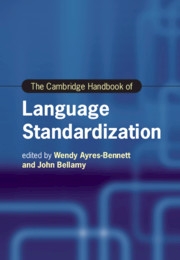Book contents
- The Cambridge Handbook of Language Standardization
- cambridge handbooks in language and linguistics
- The Cambridge Handbook of Language Standardization
- Copyright page
- Contents
- Figures
- Tables
- Contributors
- Introduction
- Part I Revisiting Models and Theories of Language Standardization
- 1 Modelling Language Standardization
- 2 Language Standardization ‘from Above’
- 3 Language Standardization in a View ‘from Below’
- 4 Social Cohesion and Emerging Standards of Hindi in a Multilingual Context
- 5 Standardization in Highly Multilingual National Contexts
- 6 Standardization of Minority Languages
- Part II Legitimacy, Authority and the Written Form
- Part III Norms, Literacy and Education
- Part IV Beyond the National
- Part V Standardization in Late Modernity
- Name Index
- Subject Index
- References
5 - Standardization in Highly Multilingual National Contexts
The Shifting Interpretations, Limited Reach and Great Symbolic Power of Ethnonationalist Visions
from Part I - Revisiting Models and Theories of Language Standardization
Published online by Cambridge University Press: 01 July 2021
- The Cambridge Handbook of Language Standardization
- cambridge handbooks in language and linguistics
- The Cambridge Handbook of Language Standardization
- Copyright page
- Contents
- Figures
- Tables
- Contributors
- Introduction
- Part I Revisiting Models and Theories of Language Standardization
- 1 Modelling Language Standardization
- 2 Language Standardization ‘from Above’
- 3 Language Standardization in a View ‘from Below’
- 4 Social Cohesion and Emerging Standards of Hindi in a Multilingual Context
- 5 Standardization in Highly Multilingual National Contexts
- 6 Standardization of Minority Languages
- Part II Legitimacy, Authority and the Written Form
- Part III Norms, Literacy and Education
- Part IV Beyond the National
- Part V Standardization in Late Modernity
- Name Index
- Subject Index
- References
Summary
Standard languages have high symbolic significance but little actual use in highly multilingual national contexts. This chapter explores the tension between the reification of fluid language use into codified languages and fluid and variable communicative practices in speech and writing in a number of African sociolinguistic settings. Starting with the observation that the notion of standard languages and of the ethnolinguistic groups using them goes back to the colonial period, I proceed to investigate different visions of language as they emerge from the writing conventions and language visions of colonial/anticolonial actors from this time, focusing on a case study on the West Afrian Manding cluster. I continue to explore attitudes to purity and standardization in contemporary scripts and language policies and in written and spoken language use, also including so-called mixed registers such as Urban Wolof and Sheng. I end the chapter by presenting innovative approaches to bypassing the standard (yet maintaining compatibility with it), focusing on the LILIEMA programme for inclusive education in a highly multilingual region of Senegal.
Keywords
- Type
- Chapter
- Information
- The Cambridge Handbook of Language Standardization , pp. 139 - 169Publisher: Cambridge University PressPrint publication year: 2021
References
- 2
- Cited by



